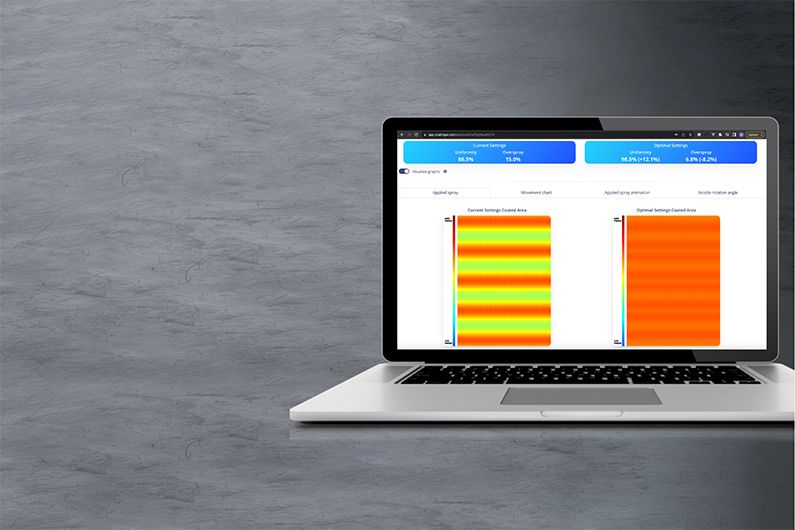More news
- Focus on the global coatings market: Global coatings market outlook
- Innovative coatings mitigate effects of deepening climate change
- View from the UK: Navigating chemical policy and sustainability
- Focus on adhesives: Unveiling unbreakable bonds – Testing redefines physical strengt...
- Focus on adhesives: Henkel and Covestro collaborate for sustainability of engineered wood ...

AkzoNobel has recently co-developed software with startup company coatingAI for use in its Powder Coatings business. PPCJ spoke to Remco Maassen van den Brink, Marketing Director of AkzoNobel’s Powder Coatings business, to discover how this industry-first technology, called Flightpath Pro, uses AI to improve their customers’ sustainability credentials
Main image caption: Comparison of the before and after using Fligtpath Pro. Second picture shows a homogeneous spraying pattern
 Q. Firstly, what does Flightpath Pro do and how does it use AI to improve the powder coatings application process?
Q. Firstly, what does Flightpath Pro do and how does it use AI to improve the powder coatings application process?
A. Flightpath Pro is software that enables customers to optimise equipment settings, such as gun motion or distance to parts, in order to optimise the consistency of the spray pattern. The AI-powered recommendations result in more uniform coatings with fewer flaws. The software doesn’t require complex integration and, as conditions change, it continually adapts its recommended parameters.
Q. How did this partnership between AkzoNobel and coatingAI come about?
A. We crossed paths with coatingAI via AkzoNobel’s Paint the Future start-up challenge in 2021. Their concept of using artificial intelligence (AI) to improve coating application fitted perfectly with our brand strategy. By building meaningful partnerships and using the latest technologies, we aim to innovate in the way we serve our customers. We set up a strategic workshop at our Como manufacturing site in Italy to define our future collaboration. By combining our Technical Service team’s deep knowledge of coatings application with the agility and expertise of coatingAI, we managed to co-develop software that’s fully tailored to our specific needs.
Q. How does Flightpath Pro improve the sustainability credentials of a powder coating?
A. The Flightpath Pro software we developed with coatingAI optimises equipment settings at the customer line to reduce defects and overspray and improve powder consumption and quality – helping powder coaters to reduce costs, avoid rework and save time and energy.
Q. Are there other benefits, aside from the sustainability angle?
A. Flightpath Pro is very user-friendly software that can be used by all our Technical Service teams globally in various ways, depending on customer requirements. It can be used remotely to assess the overall quality of the coating application, or it can be used at the customer line to calibrate with a specific powder to fine-tune the optimum application parameters even further.
READ MORE:
“The number one challenge for the coating industry today is decarbonisation”
Q. AI is a huge topic in the industry at the moment. Is AkzoNobel using it in other ways as well?
A. AI can transform how we work. At AkzoNobel, we’re exploring various possibilities with AI that could further improve customer experience, for example through process simplification and operational efficiency.
 Q. What, in your opinion, is the biggest challenge in terms of sustainability in the powder coatings industry today? How does AkzoNobel plan to overcome it?
Q. What, in your opinion, is the biggest challenge in terms of sustainability in the powder coatings industry today? How does AkzoNobel plan to overcome it?
A. Nowadays, businesses are more mindful of the impact that product materials and processes – both upstream and downstream – can have on energy consumption and the environment. They’re also mindful of the impact of rising energy prices and the challenges of future availability and supply. It was for these very reasons that we developed Interpon Low-E, a powder coating specially engineered for curing at lower temperatures, consuming less energy and accelerating production. In a typical coating line, a switch to Low-E reduces the curing temperature required by 30°C (down from 180°C to 150°C), and in doing so cuts energy consumption by as much as 20%. Alternatively, it can improve productivity, curing up to 25% faster compared with a “standard” powder coating.Some of the ways we’re helping to raise awareness of sustainability across the industry include:
- Measuring carbon footprint impact at every step of the value chain – we have Environmental Product Declarations and a carbon footprint calculator that can help with this process
- Reducing carbon footprint– we set a science-based target of 50% less carbon emissions in our own operations and across the value chain by 2030 on a 2018 baseline. For our own operations, we’re moving to renewable electricity and cutting our overall energy consumption. Across our value chain, we engage with our suppliers and are developing sustainable solutions that help our customers to reduce their carbon footprint
- Helping our customers to understand their carbon footprint and reduce it by switching technology or changing curing parameters
READ MORE:
Q. How do you balance the need for sustainable credentials in a product and the need for hard working, durable protective products? Overall, are your customers more interested in performance or sustainability?
A. Sustainability can’t be looked at from a single angle and not at the expense of product quality or lifetime expectancy. For many years, we’ve been developing more durable products (e.g. superdurable, hyperdurable, Interpon X-Pro, Interpon Redox primer) and actively promoting these solutions on the market. The future of powder coatings will be to combine durable products with lower carbon footprint impact (e.g. Interpon D Low-E, Interpon Redox One Coat).
Q. And finally, do you envision this technology being applied to any other areas of coatings, such as liquid coatings, at any point?
A. Based on our positive experiences with coatingAI in the powder coatings industry, we’re exploring the use of this AI technology in liquid coating environments.







